
59 minute read
ADMINISTRATION: From the initiation
HEALTH CARE
INSPIRED GROWTH A blog on healthy childhood development grew into a nonpro t storefront facility in Bedford. PAGE 12
Advertisement























The right prescription
If Ohio House Bill 177 passes, APRNs will be allowed to prescribe independently without having an agreement with a collaborating physician. But physician groups say the requirement should stay.
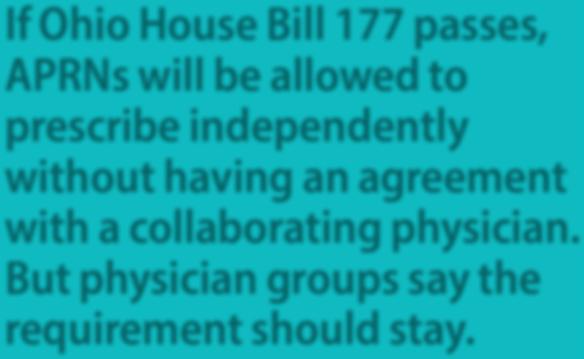
Y B LYDIA COUTRÉ
Ohio’s advanced practice registered nurses (APRNs) have turned to the state legislature to seek autonomy in their ability to prescribe and practice, a move that physician groups in the state strongly oppose.
ere have been several unsuccessful attempts in recent years to pass such a bill, but supporters of House Bill 177, which is currently in committee, are hopeful that this time will be di erent, especially given the Federal Trade Commission’s January letter urging the Ohio legislature to adopt the proposal.
Currently, before engaging in practice, APRNs must enter into a standard care arrangement with a collaborative physician who provides oversight of the care provided by these advanced practice nurses. e Ohio Association of Advanced Practice Nurses (OAAPN) states that lifting the mandatory agreement would help increase access to quality, cost-e cient care. Physician groups have pushed back, saying the current model of physician-led, teambased care is e ective and ensures patients receive safe care.


Therapists’ healthy childhood blog branches into nonprofit play facility
BYBDOUGLAS J. GUTH
Thoughts of a treehouse may conjure comfy memories of hours spent fr olicking in the summertime twilight with friends.
While that feeling may not be exactly what Claire Heffron and Lauren Drob njak had in mind when launching The I nspired Treehouse — an online platform promoting healthy childhood development — the business partners did w ant to convey images of a friendly atmosphere open to all.
“It sounded childlike and playful and a warm place to be,” said Hef fron, a career occupational therapist who s tarted the blog and online business with Drobnjak in 2013. Their pl atform provides information, resources and digital products promot ing developmental growth in the classroom or at home. With a following of p arents, teachers and therapists, the blog’s larger goal is to conquer the road blocks that arise for children at all levels of ph ysical and cognitive capability. Posts tout the fine motor and sen sory skills crucial to a child’s development, as well as activities organized by season, holiday and other k id-friendly themes. One popular post on sensory processing covers strategies to help children pay atten tion, including the use of fidget toys for kids to hold when their attention is needed for extended periods.
Valuable tips collected over de cades of professional child therapy exp erience inspired the Treehouse’s initial launch. Heffron and Drobnjak met in the mid-2000s at Bedford City Schools: Heffron previously worked in the autism program at Achieve ment Centers for Children, while pediatric therapist Drobnjak had skilled n ursing knowledge.
“We knew we had so many great ideas, we toyed around with a brickand-mortar space and what we could do with it,” Drobnjak said. “Our busi ness mentor suggested writing down a b usiness plan first, and suggested the blog format.”
Lauren Drobnjak (left) and Claire Heffron host small playgroups for children of all abilities at The Treehouse in Bedford. | CONTRIBUTED

State of play
Although a blog may not have been in their original plans, the partners can’t deny its popularity. Their site gets 200,000-300,000 page views monthly, including 245,000 views via 131,000 unique visitors in January 2020.
Alongside informative posts, In spired Treehouse offers an array of do wnloadable therapy tools and resources. “Children & Nature Toolkit” is a $15.99 e-b ook that incorporates the natural world into therapy prac tice. Using evidence-based information compiled by the authors, teachers can identify nature-related activities tar geting self-care, taking turns, self-control and other skills needed for developmental growth.
Meanwhile, free printables teach children how to improve core strength by moving their bodies. Building torso muscles for better posture and motor skills doesn’t have to be boring, so the entrepreneurs implemented card games and yoga moves for tiny folks to get strong middles.
“There’s some targeted exercises, but it’s exercise through play, so kids don’t realize they’re working on core strength,” explained Heffron. “The big thing for me and Lauren is that presen tation doesn’t matter unless people can under stand it. If we can provide something that’s accessible and well-designed, people will be drawn to it.”
Getting physical
Accessibility is also the watchword for a nonprofit studio space the pair opened as an addition to their online business. Simply called The Tree house, the 1,200-square-foot Bedford s torefront organizes free and lowcost developmental play groups for all children regardless of ability level. Play sessions at the 2-year-old fa cility last from 60-90 minutes, integrating motor and sensory activities r elated to a playful theme. A circus-centric gathering may have participants balancing beanbags on their he ads or sharpening their trapeze skills by running and jumping thr ough an obstacle course. “There are different themes each week, so kids are never coming in doing the same things,” Heffron noted. “De pending on the theme, we’ll bounce fr om movement to tabletop activities.”
The Broadway Avenue space, in past iterations a hair salon and Indi an grocery store, also hosts yoga and m usic-therapy sessions, as well as training for teachers keen on glean ing new ideas for the classroom. P lay groups — which typically accommodate six to eight participants — are split between typically functioning children and those with special needs. The latter group may be on the autism spectrum or have physical impair ments and behavioral issues that make it difficult for them to transition between activities. Ranging in age from 2 t o 10, the small groups mix well, with typically functioning attendees often serving as activity leaders.
“If there are kids having a hard time taking turns, their peer models will demonstrate that for them,” Hef fron said. “Children don’t perceive dis abilities the same way adults do. They just see buddies to play with and don’t see limitations as much. It’s a nice, handy way to incorporate acceptance. It comes very naturally most of the time.”
The Treehouse currently hosts chil dren from Bedford, as well as Lakewood, Parma and Cleveland. Programs are free for once-a-week guests, while addition al classes are $5 each. About 80 kids attend sessions each week and 300 families total, with word spread mostly by referral.
“Some families are working multiple jobs to make ends meet, and we have so many teachers coming to us saying their kids need help,” Drobnjak said. “This was the perfect opportunity to grab kids who don’t have an identified need, but definitely have a need. We knew we had the skills and resources and wanted to be able to do this for anyone, whether they can afford it or not.”
The Treehouse, a 501(c)(3) organi zation, relies on contributions from individuals and corporations. Considering there’s a waiting list for play groups, the en trepreneurial twosome would be thrilled to open their welcoming envi ronment to additional newcomers. “ It gives parents peace of mind to have a place offering these beneficial services while they get a break,” Hef fron said. “Not having that waiting lis t would be awesome.”
Contact Douglas J. Guth: clbfreelancer@crain.com
R eginald Fields, spokesman for the Ohio State Medical Association, said he recognizes this is a “delicate” issue. Nurses, nurse practitioners and other professionals play vital roles in health care delivery, but the team needs to remain physician-led, he said, noting physicians have significantly more education, training and experience.
“Physicians and nurses could not be effective without one another, but to essentially want to completely eliminate a physician from a patient’s team-based care is ... not a good idea, and it really jeopardizes an individu al’s safety,” Fields said. J eana Singleton — an attorney at Brennan, Manna and Diamond, whose team serves as general counsel for OAAPN — stresses that lifting the mandatory standard care arrange ment does not mean ending the collaborative, team-based approach. As he alth care leaders encourage providers to practice to the top of their license, the question becomes what is that highest point.
“If APRNs are better able to practice to the full extent of their education,
Fields
Greaves
training and abilities, and if institution al health care providers are better able t o deploy APRNs as needed, health care consumers are likely to benefit from improved access to health care, lower costs and additional innovation,” according to the FTC letter.
John A. Bastulli — vice president of legislative affairs for the Academy of Medicine of Cleveland and Northern Ohio, the regional physician organi zation — argues that APRNs are already there. “They are currently w orking at the top of their license,” he said. “What they are seeking is to ex pand their scope of practice and to pr actice independent of a care arrangement with a physician that they h ave a supervisory agreement with.” The standard care arrangement was instituted in the 1990s, but times have changed since then, Mary Jane Maloney, director of the Government Relations Committee for the OAAPN, argued in prepared testimony for an Ohio House of Representatives Health Committee hearing on the bill in late January. Ohio’s growing elderly popu lation, with multiple chronic health pr oblems, and the increase in the insured population have expanded the ne ed for health care services and primary care providers, according to her wr itten testimony. Joscelyn Greaves, OAAPN presi dent, said the biggest thing the bill w ill accomplish, if passed, is increasing access to care, which she said is a “h uge need” in the state. Kaiser Family Foundation has identified 155 primary care health professional shortage areas in Ohio, pr edominantly determined by the number of health professionals relative to the popula tion with consideration of high need. “W e have 17,000 APRNs in the state,” Greaves noted. “We want to be able to remove that barrier and allow us to be able to go into those areas where there’s minimal health care available at this point.”
Greaves added that as more health care systems acquire practices, there are fewer physicians available to enter into standard care arrangements because
they often aren’t allowed to collaborate with APRNs who aren’t a part of these large systems.
Fields said he doesn’t see a risk of APRNs being unable to access a col laborative physician, claiming there ar e physicians out in rural areas of the state who are available if APRNs want to practice there under a stan dard care arrangement. “ It’s just an argument that may be true for other states, but it’s not true here in the state of Ohio. We don’t see that level of shortage,” he said.
Roughly half of U.S. states require some form of physician supervision for APRNs, but the specifics vary.
In Ohio, there’s a baseline of specif ic times when APRNs can diagnose and pr escribe, Fields said. The agreement with a physician spells out how the t wo will collaborate on conditions and situations beyond that.
“So the physician essentially serves as really a safety buffer for when you have some higher-level medical atten tion that’s needed," he said. F or example, a nurse practitioner may be able to prescribe something for a basic cold, but for a more medi cally complicated situation, “there ar e clear lines where the physician needs to be involved and should be consulted,” Fields said.
In its letter, the FTC, which also encouraged Kansas legislatures to pass a similar bill, highlighted con cerns about competition in health c are, noting that even “well-intentioned” regulations could have overbroad, unnecessary restrictions that limit com petition. “Undue regulatory restrictions on APRN practice can harm patients, insti tutional health care providers and both p ublic and private third-party payors,” the letter stated, citing a 2014 FTC policy paper which said that “state- mandated supervision of APRN practice raises competitive concerns, may impede ac cess to care and may frustrate the development of innovative and effective mo dels of team-based health care.” Bastulli said physicians are “very willing” to engage with APRNs to ad dress access and cost containment. Pr evious legislation expanded the number of APRNs in a supervisory agreement and liberalized the formu lary of medications they could administer, “while at the same time maintaining physician supervision as part of the he alth care team,” he said.

Y B FRANK SPINELLI
For years, employer groups have embraced the idea of adopting a de- ned contribution health insurance delivery model to better manage and control what in many cases is the second-largest expense in their budget. Recent federal legislative and regulatory initiatives expanding the use of health reimbursement arrangements (HRAs) may prove to be the best vehicle to clear a new path for de ned contribution in health care.
E ective Jan. 1, employers can o er, on a pre-tax basis, what is called an Individual Coverage Health Reimbursement Arrangement (ICHRA – “ick-rah”) instead of o ering a group health plan. Just as the shift from de ned-bene t pensions to de ned-contribution 401(k) plans altered how Americans save for retirement, ICHRAs could have a similar e ect on how employers of all sizes fund and manage employee health bene ts.
While traditional group health insurance will continue to prove the more favorable route for many, this new tool is widely viewed as a way to strategically position bene ts o erings while controlling costs and, at the same time, expand employee choice. rough the rule’s provisions, employers may elect to replace part or all of their group health plan with a de- ned-contribution ICHRA. is will allow employers to reimburse employees for some or all of the premium cost of individual health and Medicare plans that their employees will purchase in the individual market.
In January, Stan Sieniawski, practice leader of Oswald’s Medicare and Individual Health Solutions practice, attended a Washington, D.C., roundtable where he joined leaders from the Departments of Labor, Treasury, Health and Human Services and the Centers for Medicare and Medicaid Services to discuss the administration’s goals regarding ICHRAs.
e governmental agencies projected it will take approximately ve years to fully adjust to the updated rules, at which time an estimated 800,000 employers will o er ICHRAs covering approximately 11 million employees and dependents.
e agencies further indicated that ICHRAs may serve to appeal to two large and distinct employee segments: baby boomers and millennials. Baby boomers, many of whom are working beyond age 65, may appreciate the broader network access and lower outof-pocket costs a orded through Medicare, while millennials could welcome the plan choice and having control over their health insurance.
The mechanics
When properly situated, an ICHRA program eliminates the risk of both the 4980H(a) and (b) Employer Shared Responsibility penalties by following several safe harbor rules that have been established to ensure a ordability.
e law introduces a fresh strategic opportunity — however, the regulations and “small provisions” could be the framework for unintended consequences.
ese caveats include, but aren’t limited to: Speci c permissible classes of employees, as de- ned by the law. All participants must be enrolled in an individual health or Medicare program. e ICHRA policy must use “reasonable procedures” to substantiate participants are enrolled in coverage. An organization may not o er both a group health plan and an ICHRA to the same class of employees. An ICHRA must be o ered on the same terms to all employees within a speci ed allowable class. e list of provisions is complex and confusing, but the e ort will be worth it for employers who seek a new way to position their employee bene ts o ering. Spinelli is vice president, director of a nity groups and emerging markets, for Oswald Cos.
Early ndings
Having analyzed scores of possible ICHRAs for employers since late 2019, we have found that approximately 40% make sound nancial sense. Our experience, from the dozens of companies we have implemented or are currently implementing, has taught us that a successful ICHRA rollout relies on three major areas:
1. STRATEGY/DESIGN AND COMPLIANCE: Analyze and design a plan that is right for organizational nancial goals and culture, including providing the necessary model notices and legal documents to ensure compliance.
2. EMPLOYEE ENGAGEMENT AND ENROLLMENT: An education, communication and rollout strategy are paramount to a positive experience. Employers need to provide opportunities to have individual health insurance specialists meet one-on-one with employees to assist them in making informed individual health insurance decisions.
3. ADMINISTRATION: From the initiation and communication of the program to the management and delivery of monthly employee reimbursements, the new program comes with a host of new administrative functions, all of which must be handled systematically.
If we have learned anything about the health insurance industry over the past decade, it is that things change and they change quickly. e ICHRA regulations allow an opportunity for those seeking a path to de- ned contribution and a path for those who seek to get out of the annual health renewal game.
Is ICHRA a health insurance gamechanger? While the nal answer will require time, all indications are that the answer for many will be yes.
BLESSING OF PEACE Planned or deferred gifts to Malachi House are one of the most important ways you can help us build our endowment to ensure our home will always be there in perpetuity for those who need us most, when they need us most. It is difficult to see our residents come to Malachi House in their terminal state, many times with fear and confusion in their eyes. As the days and weeks go by, it is truly a blessing to witness their transformation as they smile, enjoy home cooked meals, feel a sense of family and engage with volunteers, hospice teams, staff and board members. The peace they ultimately experience is a result of the loving care they receive. Won’t you consider being a part of that peace?
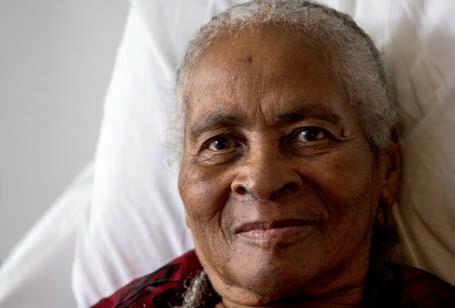
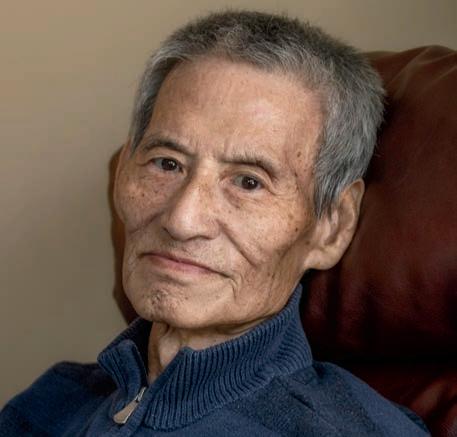
Judy Ghazoul Hilow, Executive Director jhilow@malachihouse.org
| QUESTIONS? 216.621.8831 |
Jena Olsen, Development Coordinator development@malachihouse.org


STAY IN THE KNOW with Crain’s email newsletters Subscribe FOR FREE by visiting CrainsCleveland.com/enewsletters
Learn the Art and Science of Selling The Desich Sales Institute
A 7-session series that will help both your new and seasoned sales professionals understand the science of the buying decision and internal questions that customers commonly ask.
Session Topics: • Prospecting and Qualifying • Preparation and Pre-Approach • Approach • Presentation • Overcoming Objections • Closing the Sale • Follow-up Sessions begin February 26 and run through April 18. Each topic is offered on Wednesdays at 6 p.m. or Saturdays at 8:30 a.m. Attendees may go to either topic session. Attendance at all 7 is required to earn the Certificate of Advance Professional Sales.
For more information or to register, call Jim Walborn at (440) 366-4323 or email him at: jwalborn@lorainccc.edu.
The training will be held at the LCCC Richard Desich Entrepreneurship Center on the LCCC Campus, 1005 N. Abbe Road, Elyria.
Entrepreneur leverages tech to improve health care access in Northeast Ohio and around the world
Y B JUDY STRINGER
When then-Ohio attorney general Mike DeWine told PartsSource founder Ray Dalton the state needed more detox beds to meet escalating demand, Dalton asked how DeWine knew that was the case. It was early 2017 and the opioid epidemic was raging, with Ohio among the hardest hit, Dalton said, but no one was tracking the state’s addiction response capacity or availability.
“DeWine’s answer was, ‘Well, you’re the tech guy. Why don’t you go gure it out?’ ” he recalled. “So we set out to do that.”
Under the auspices of e Dalton Foundation — an Aurora-based charity established in 1999 — the serial Northeast Ohio entrepreneur hired four “area reps” to map out Ohio health care facilities that o er substance abuse services. en, later that same year, he launched reLink. org, a geolocated, real-time platform for connecting people struggling with addiction to treatment resources in their area.
Today, Dalton said, the website includes “every type of service to the addiction marketplace, from detox to housing to employment,” and has been expanded to encompass re-entry help for former convicts and social service resources for victims of human tra cking.
“We have more than 8,000 organizations across the state listing the availability of over 100,000 recovery and re-entry services,” he said. “And it’s a free service that is now being used about 1,200 times a week.”
Physicians and nurses at the Ohio State University Wexner Medical Center and Nationwide Children’s Hospital, for example, rely on reLink. org to place discharged overdose patients into rehab beds and/or to help the patient’s loved ones locate addiction education or counseling. Administrators and counselors a liated with the Ohio Department of Rehabilitation and Correction refer inmates and their families to reLink. org to nd agencies and nonpro ts with prerelease resources like workforce readiness, upskilling and job placement.
Across Ohio, however, more people log onto the site from public libraries than from homes, hospitals, jails or any other type of location.
“If you’re homeless or you’ve been thrown out of your home, or when you’re down and out and nobody’s there to help, where do you go to use a computer safely? e public library,” Dalton said. “Our goal was three clicks, three seconds and at least three answers. at’s really what we strive to do.”
ReLink.org is Dalton’s newest venture. In addition to Aurora-based PartsSource, a fast-growing medical parts supplier purchased by Great Hill Partners in 2017, Dalton founded two medical device repair companies, NationalMD and OneSource Services, which were acquired by General Electric Medical Systems, in 1996 and 2000, respectively.
He said a fraction of pro ts from those sales — particularly the PartsSouce divestiture — support the Dalton Foundation and its programming. ReLink Medical, a Twinsburg “THIS IS AN EXPENSIVE PLATFORM THAT WE’RE FUNDING, BUT WE REALLY BELIEVE IT IS SAVING LIVES.”
— Ray Dalton, founder and chairman, The Dalton Foundation
company that sells, recycles or otherwise safely discards retired medical equipment, also provides ongoing funding for the foundation, according to Dalton, who established that company in 2015 with his son, Je .
e 50-person ReLink Medical cleared nearly $13 million in 2019, the elder Dalton said, and provides 10% of its earnings to the foundation. “We have contracts with about 1,000 hospitals across the U.S., where we take all the equipment they’re getting rid of or updating or consolidating, bring it to our Enterprise Parkway facility, where it can be cataloged and tested, and then repurpose that equipment all over the world,” he said.
Roughly 15% of ReLink Medical’s recaptured equipment makes its way to developing nations through ReLinkGlobalHealth.org, an arm of the family foundation that “works with organizations and hospitals in developing countries,” Dalton said, “to strategically understand the kind of equipment that they need and help them obtain that equipment.”
Like ReLink.org, that initiative began with logging existing assets. Dalton said the foundation partnered with government agencies and NGOs in Haiti to create a digital database of medical providers and the equipment available in hospitals and clinics across the country. ReLinkGlobalHealth.org then helps those organizations source used equipment from ReLink Medical to fill any gaps and provides funding for shipping expenses, when appropriate.
“We also help them develop a training program,” he added, “so when they receive the equipment, they know how to use it, and a service strategy, so they know how to get it working and continue to keep it working.”
In addition, individual Haitians can use the website to nd medical services and providers.
e Dalton Foundation has spent about $2 million building out these searchable databases, and Dalton estimated it costs another $600,000 per year to keep them up and running. He said the foundation has not solicited much in the way of outside resources in its quest to leverage technology as a tool to improve health care access to vulnerable populations. To him, it’s a ministry as much as a mission.
“ is is an expensive platform that we’re funding,” Dalton said, “but we really believe it is saving lives.”
Contact Judy Stringer: clbfreelancer@crain.com
Crain’s Cleveland Business is celebrating its 40th anniversary in 2020. As part of that, Crain’s Newsmaker Awards will recognize at this elite luncheon some of the top newsmakers in Cleveland who have paved the way for businesses, leaders and Northeast Ohio.
MARCH 25 //11 A.M. Rocket Mortgage FieldHouse

TITLE SPONSOR
TECHNOLOGY PARTNER
Join us for a panel discussion celebrating the accomplishments of these key individuals and organizations from the last four decades.


1980s
ROCK & ROLL HALL OF FAME // Mike Benz COMMUNITY DEVELOPMENT // Cleveland’s Neighborhoods
1990s

GATEWAY PROJECT // Tom Chema FRED NANCE // The Return of the Cleveland Browns
2000s
CLEVELAND’S RISE // Economic Development Organizations HEALTH CARE // Growth of the Cleveland Clinic
2010s
DAVID GILBERT // Republican National Convention KEYCORP // Expansion and Growth
REGISTER TODAY: CrainsCleveland.com/Crains-Events



RANK RECIPIENT DONOR (CONNECTION TO RECIPIENT) AMOUNT DATE DESCRIPTION DEVELOPMENT CONTACT 1 Cleveland Clinic The Lord Foundation of Ohio $261,668,808 Oct. 2019 Research and education Cindy Fink 216-448-0663
Cleveland Clinic Jack, Joseph and Morton Mandel Foundation $23,000,000 July 2019 Global leadership training Cindy Fink 216-448-0663
John Carroll University Anonymous (Graduate) $20,000,000 Feb. 2019 Unrestricted Doreen Riley 216-397-1990
University Hospitals Sarah S. and Alexander M. Cutler $15,000,000 Oct. 2019 Men's comprehensive care Sherri Bishop 216-983-2200
Akron Children's Hospital Joel and Cassie Testa; Jim and Julie Thomasson $14,800,000 March 2019 Donation of Cynthia Parker Matthews Building (Akron Children's Health Center, Boston Heights) (1) Shelly Brown 330-543-8900 Cleveland Foundation Anonymous $10,477,034 Dec. 2019 Named fund to support various nonprofits Kaye Ridolfi 216-861-3810 Case Western Reserve University Coleman and Susan Burke Foundation Inc. (Alumnus - Coleman Burke) $10,000,000 Jan. 2019 The Coleman P. Burke Environmental Law Center Abby Mitchell 216-368-4352 Cleveland Clinic Stephen D. Rosenthal $10,000,000 April 2019 Heart & Vascular Institute Cindy Fink 216-448-0663 University Hospitals Roe Green $9,000,000 May 2019 Travel medicine and global health Sherri Bishop 216-983-2200 Case Western Reserve University Anonymous (Alumnus) $8,500,000 Aug. 2019 Merit scholarships in the College of Arts and Sciences and School of Medicine Abby Mitchell 216-368-4352 Walsh University Rambo family (Alumni) $8,300,000 June 2019 Program development, scholarships and lab updates for Byers School of Nursing Eric Belden 330-490-7337 Baldwin Wallace University Austin E. Knowlton Foundation $8,000,000 Oct. 2019 Knowlton Center (new math, computer science, engineering and physics building) Robert Helmer 440-826-2424 Cleveland Foundation Holsey Gates Handyside Trust $6,715,966 Dec. 2019 Various existing Cleveland Foundation funds Kaye Ridolfi 216-861-3810 The Cleveland Museum of Art Anonymous (Trustee) $6,000,000 June 2019 Curatorial endowment Colleen Russell Criste 216-707-2154 Case Western Reserve University Anonymous $5,600,000 Sept. 2019 Scholarships in the College of Arts and Sciences Abby Mitchell 216-368-4352 Cleveland Clinic Samuel H. and Maria Miller Foundation $5,500,000 Dec. 2019 Emergency services Cindy Fink 216-448-0663 Case Western Reserve University Thomas M. Becker (Alumnus) $5,000,000 June 2019 Thomas M. Becker, MD Professorship at the School of Medicine Abby Mitchell 216-368-4352
Cleveland Clinic Anonymous $5,000,000 Nov. 2019 Unrestricted Cindy Fink 216-448-0663
Cleveland Clinic Edward J. DeBartolo Jr. $5,000,000 Dec. 2019 Autism scholarships and Cleveland Clinic Children's Cindy Fink 216-448-0663
Cleveland Neighborhood Progress Cleveland Foundation $5,000,000 April 2019 Three years of operational and program support; management of Strategic Investment Initiative Andrew Harris 216-453-1457
Cleveland Clinic The Ralph C. Wilson Jr. Foundation $4,975,000 Feb. 2019 THRIVE Program for caregiver education and retention Cindy Fink 216-448-0663
Case Western Reserve University Anonymous $4,700,000 Feb. 2019 STEMpower Global Fellows Endowed Fund Abby Mitchell 216-368-4352
Case Western Reserve University Anonymous $4,200,000 Dec. 2019 Oral health research Abby Mitchell 216-368-4352
Case Western Reserve University Bill and Melinda Gates Foundation $4,100,000 Nov. 2019 HIV research in developing countries Abby Mitchell 216-368-4352
Cleveland Clinic Anonymous $4,000,000 March 2019 Neurotechnology research Cindy Fink 216-448-0663
The Youngstown Foundation Judge William Rayen Trust $4,000,000 Jan. 2019 Youngstown City School District (educational purposes) Janice Strasfeld 330-744-0320
Cleveland Neighborhood Progress The George Gund Foundation $3,600,000 April 2019 Three years of operational and program support Andrew Harris 216-453-1457
Cleveland Foundation Franklin G. Smith Trust $3,533,490 Jan. 2019 Named fund to support various nonprofits Kaye Ridolfi 216-861-3810
Playhouse Square Lori and Rick Buoncore (Board member - Rick Buoncore) $3,500,000 Aug. 2019 Advancing the Legacy Campaign for Playhouse Square Michelle Ryan Stewart 216-640-8410
Hiram College Harlene Lee (Graduate) $3,287,207 Aug. 2019 Student health/athletics and endowed scholarships for students Jennifer Schuller 330-569-5839
Stark Community Foundation Anonymous $3,100,000 Nov. 2019 Named fund to support the donor's charitable interests Bridgette Neisel 330-454-7992
Case Western Reserve University The Ralph T. and Esther L. Warburton Foundation $3,000,000 Aug. 2019 Scholarships for dental medicine, medicine and nursing students Abby Mitchell 216-368-4352
Case Western Reserve University, Cleveland Museum of Art Anonymous (Alumna of CWRU; honorary trustee with CMA) $3,000,000 Dec. 2019 Capital improvement Abby Mitchell 216-368-4352 Colleen Russell Criste 216-707-2154 Cleveland Clinic Anonymous $3,000,000 Oct. 2019 Congenital heart surgery research Cindy Fink 216-448-0663 Cleveland Clinic Anonymous $3,000,000 Dec. 2019 Research Cindy Fink 216-448-0663 The Cleveland Museum of Art The Kelvin and Eleanor Smith Foundation (Trustee) $3,000,000 April 2019 Capital improvement Colleen Russell Criste 216-707-2154 The Cleveland Orchestra Anonymous
(Longtime supporter) $3,000,000 Nov. 2019 Education concerts Jane Hargraft 216-231-7520 University Hospitals Anonymous $3,000,000 Aug. 2019 UH Seidman Cancer Center Sherri Bishop 216-983-2200
With a history rich of immigrants but marked by poverty, Cascade Valley is on the rise in eyes of developers
BYBDAN SHINGLER
You’d never know it today, but Cascade Valley used to be one of Akron’s most densely populated neighborhoods. N ow, the neighborhood just north of downtown sits mostly vacant but is attracting development once again. “At one time, there was a ton of hous es on all these little streets, but they were k ind of slums,” said Jason Segedy, Akron’s director of planning and urban de velopment. “They were shacks and cottages that were really run-down, and they were the first things to go back in the 1950s,” when much of Akron’s urban areas were redeveloped and blighted areas were cleared.
The portion of the neighborhood most folks know best is usually consid ered part of downtown Akron, but is act ually in Cascade Valley, Segedy noted. That includes the city’s popular Luigi’s Restaurant and Jilly’s Music Room, b oth on North Main Street, as well as the Northside Lofts and Northside Marketplace on Furnace Street, built by developer Joel Testa. The area also includes the Courtyard Marriott, which has been downtown’s major hotel since it opened in 2016. But while that’s the hot spot today, it’s the area farther north, where there is little develop ment today, that Segedy and others hop e to see gaining increased activity and new construction.
Segedy knows the city like some one who’s proud to have been a map and history nerd his whole life, but he’s got a special connection to this neighborhood.
“My great-grandparents lived in that house,” he said, pointing to an old, roy al blue spot on Mustill Street. “With ei ght kids, too. There were 10 people living in that little house!”
They were part of a wave of Italian im migrants, Segedy said, setting up in Akron Italian-style, complete with chickens in the backyard, along with a pig. A t least, that’s the family legend. That was typical for Cascade Valley, he noted. It was home to wave after wave of newcomers: Irish, Italians, Ap palachians, African Americans, Eastern Europeans and others. They all cr owded into the small valley along the Little Cuyahoga River, making their lives in everything from the few houses that still exist today to ramshackle structures never meant for history.
That’s how the neighborhood re mained well into the 20th century, S egedy said.
The area was also, for a century or
About this series We thought we knew a fair amount about Akron, which is the hometown of some of us at Crain’s. That is, until we started driving around with Akron planning director Jason Segedy, who agreed to take part in an ongoing series to show us his knowledge and passion for the city — one neighborhood at a time. This month, we look at Cascade Valley, a once densely populated neighborhood that was a hot spot for the city’s jazz scene. The area is now largely vacant, but is starting to attract development again.
more, generally low-rent and highvice. As recently as the 1980s, North Howard Street was synonymous with Akron’s prostitution district. Segedy and others who love the neighbor hood’s history say its relationship w ith vices of nearly every sort goes back more than a century.
“During Prohibition in the ’20s, there were mafia-run casinos, broth els and bars down here. It’s always h ad a sort of a checkered past in terms of vice,” Segedy said.
Its low rents, however, also made it the center of something else in Akron. “That’s where jazz started here, on Howard Street. They had 10 or 15 clubs here,” said Tony Troppe, a de veloper, jazz musician and owner of the ne arby club, Blu Jazz+ on East Market Street.
Cascade Valley had a vibrant African American population and one of a lim ited number of hotels between New Y ork and Chicago that would rent a room to black musicians. As a result, Troppe said, the best jazz musicians made regular stops on Howard Street. “Akron became a very prominent place for jazz, because it was so stra tegically located, and this was the cen ter of it,” he said. Now, the place is hardly crowded with newcomers. Today, the city puts the neighborhood’s population at just over 2,200 people, but Segedy said it once held many times that number.
If you drive into the neighborhood from downtown, it begins when you hit the Northside Lofts on North Main and Furnace streets. Drive an other mile and you exit the neighborhood at Olive Street. East and west, the nei ghborhood is about threeand-a-half miles wide, straddling the Little Cuyahoga.
Much of Cascade Valley looks downright bucolic, with roads wind ing along the river and tree-covered

The Northside Lofts, left, and the Courtyard by Marriott anchor one of the more well-known areas of Cascade Valley that’s populated by restaurants and shops.

Cascade Village is a development of 300 attached homes that was built in the early 2000s, replacing subsidized housing.

hills ides all around. It’s not completely empty. For one thing, it includes Cascade Village: 300 attached, single-family homes built in the early 2000s that replaced former subsidized housing units that Segedy said were an eyesore.
“This is a great development. It re placed the projects, which were c alled Elizabeth Park. They looked like barracks and were just hid eous-looking buildings. These are b eautiful,” Segedy said.
There are also new, market-rate homes being built by Ryan Homes on what was once city-owned land on Hickory Street near Memorial Park way. The project — a mix of townhomes and stand-alone single-family homes — is R yan Homes’ first in the city. There’s already a waiting list for more than 50 homes, selling at prices north of $200,000, Segedy said.
When talking about the develop ment, which it has dubbed Hickory R anches, Ryan Homes touts the quick access to downtown Akron and proximity to Northside Marketplace, local parks and the Ohio & Erie Tow path Trail. T oday, that development and Cascade Village anchor the neighborhood, which remains pretty quiet and tr ouble-free, according some who’ve operated businesses there.
In 2018, Sean Linton moved his Fully Loaded Chew into a building that once housed an Italian soap fac tory. At the time, he wasn’t even a ware the area was called Cascade Valley. He just thought of it as the edge of downtown, and he found a reasonably priced building that worked for his company, which pro duces tobacco-free snuff. S ince then, though, he’s learned more about the neighborhood, which he said has been safe, convenient and a good place to do business.
“The transit is great: You just hop off the expressway on Perkins (Street),” said Linton, a Green resi dent. “It’s a pretty easy commute.” If the nei ghborhood has a rough history, it’s not evident today, he added. “ In 18 months being here, we’ve had zero issues. We have good sur veillance, too, but our alarm’s never e ven gone off,” he said.
Benjamin Patrick strikes a similar note. He owns and operates Akron Recording Co. in the Whitespace Building on Furnace Street, home of the former marketing agency Whitespace Creative. Patrick leases about 3,000 square feet of space in the building.
He was attracted both to the local music history and the building, which is well-known in the neighborhood because of its 2017 renovation by for mer Whitespace owner Keeven White. “ It was kind of the whole package,” Patrick said. “It’s a historic neighbor hood with Howard Street. That used t o be considered downtown Akron, and they had jazz clubs and a thriv ing jazz scene. The neighborhood is k ind of tucked away, too, which is nice for our business because we have a lot of equipment.”
His landlord, White, closed his marketing firm in the building last year but still spends a lot of time there and is continuing to renovate. White knew all about the neighborhood and its past when he moved in — it was one of the reasons he went there.
“I think the neighborhood has been fairly stable, but it’s moving up now,” White observed
White credits Troppe, whom he counts as both a friend and a mentor, for much of Cascade Valley’s recent revival. Segedy echoes that. Both said Troppe’s Cascade Lofts, 24 luxury apartments the developer created from the bones of the former Swine hart Tire & Rubber Co., have helped
ACCOUNTING LAW
Apple Growth Partners

Apple Growth Partners (AGP), award-winning accounting and business advisory firm, proudly announces the addition of Robert Jackson, CPA, MTax, to the Cleveland office as a senior tax manager. Jackson comes to AGP with a wealth of tax and public accounting experience spanning more than two decades. Spending most of his career in senior-level leadership roles, Jackson recently served as a senior tax manager and managing director for a local and national public accounting firm, respectively.
Thompson Hine LLP
Thompson Hine LLP is pleased to announce that Thomas R. Butchko has been promoted to partner in its Commercial & Public Finance practice group. Thomas focuses on the development, negotiation and documentation of senior and subordinated credit facilities, asset-based loans, senior and mezzanine debt placements, acquisition financing, structured finance transactions and other complex financing transactions involving banks and other financial institutions, as well as public and private companies.
LAW LAW
Thompson Hine LLP
Thompson Hine LLP is pleased to announce that Steven G. Stransky has been promoted to partner in its Privacy & Cybersecurity practice group. Steve, who spent 10 years serving in the federal government, including as deputy legal adviser on the President’s National Security Council and an attorney at the U.S. Department of Homeland Security, helps clients assess and mitigate cybersecurity risks and comply with federal, state and foreign laws and regulations governing data privacy and security.
Gallagher Sharp LLP
Gallagher Sharp is pleased to announce that Rema A. Ina has been named a Partner. Rema works in the Employment Law, General Liability, and Insurance Coverage practice areas. She devotes a large amount of her time to defending employers against claims involving discrimination including the FMLA, ADA, and FLSA, and provides training on sexual harassment and ADA compliance. Rema also represents insurance carriers in coverage and defense matters and frequently lectures on data and cyber security.
BANKING
The Northside Lofts, left, and the Courtyard by Marriott anchor one of the more well-known areas of Cascade Valley that’s populated by restaurants and shops. | SHANE WYNN FOR CRAIN’S
spark new interest in the area.
The apartments opened in 2017, and Troppe followed with the adjoin ing Lock 15 Brewing Co. in 2018. An optimis t with a love of historic buildings, Troppe has long been a champion for the neighborhood. He said he’s just bringing activity back to where it was meant to be, in a great neighborhood nestled up to down town with beautiful natural features. And he ’s not finished. . “We have plans to continue this development at North and Howard with another 24 units we’ll be putting atop a parking garage,” he said.
He’s also looking to build on land that he owns across Howard Street.
“That’s slated for 40 units on top of 25,000 square feet of mercantile space: retail, restaurants banking, all sorts of mixed-use,” Troppe said.
He’s renaming his part of the neighborhood “NoHo,” for North and Howard streets.
A maverick, Troppe can some times take longer than anticipated to com plete a project, but he nonetheless seems to find a way to get them finishe d, said Segedy, White and others. Tr oppe said he’s convinced the neighborhood will continue to at tract younger residents, as he said C ascade Lofts has proven it can do.
Right now, Troppe said, the area is a bit constrained by the city’s big sewer project, which has disrupted the neigh borhood with heavy construction, especially along Cuyahoga Street. Th at could be keeping some would-be residents and builders away, Troppe noted. But once the sewer work is done, he thinks the neighborhood’s location and natural features, along with the city’s current tax abatement on new residential construction, will lead to a wave of new homes and development.
“Now’s the time to get in here,” Troppe said.
Civista Bank Civista Bank welcomes Carl Kessler as Senior Vice President, Chief Information Officer. He brings over 25 years of experience in technology and cybersecurity to the Civista team; having served nearly 20 of those years working in the banking and financial industries. Kessler will lead Civista’s technology-based strategies; continuing bank efforts to provide innovative solutions and positively impact the Civista customer experience.
FINANCIAL SERVICES
Oppenheimer & Co. Inc.
Oppenheimer & Co. Inc. is pleased to announce that Adam R. Jacobs has been promoted to Senior Director-Investments bringing over 14 years of experience. Adam, as a partner of The Hartzmark Group of Oppenheimer for the past 11 years, offers guidance as a Financial Advisor helping individuals, families, small businesses & entrepreneurs plan for life’s milestones. The Hartzmark Group has a legacy in the financial service industry spanning four generations going back to the Great Depression.
LAW LAW
Thompson Hine LLP Thompson Hine LLP is pleased to announce that Thomas M. Ritzert has been promoted to partner in its Business Litigation practice group. His experience includes cases involving fiduciary relationships; shareholder disputes; business torts; trade secret and non-compete matters; commercial and contract disputes; and eminent domain and property matters. Tom also defends corporations and directors in class and derivative shareholder actions challenging mergers, acquisitions and tender offers.
LAW
Thompson Hine LLP
Thompson Hine LLP is pleased to announce that Andrea R. McCarthy has been promoted to partner in its Corporate Transactions & Securities practice group. Andrea advises public companies on securities and general corporate matters, such as federal and state securities law filings and compliance. She has experience with transactions including follow-on and secondary offerings, IPOs, private placements, venture capital financings, and public and private company mergers and acquisitions.
Thompson Hine LLP Thompson Hine LLP is pleased to announce that Jim Henderson has been promoted to partner in its Business Restructuring, Creditors’ Rights & Bankruptcy practice group. Jim focuses his practice on representing secured lenders in workouts, Uniform Commercial Code issues, and other bankruptcy, finance and commercial law matters. He received his J.D., cum laude, from the Case Western Reserve University School of Law.
LAW
Taft Stettinius & Hollister LLP Jennifer E. Horn has joined Taft as an attorney in the Business and Finance group. She focuses her practice on mergers and acquisitions, private equity and venture capital transactions. Jen has served as outside corporate counsel to several global corporations. She has experience working with new and emerging companies, corporate entity selection and formation, and a wide range of general corporate matters. Jen received her J.D., cum laude, from Cleveland-Marshall College of Law.
LAW
Gallagher Sharp LLP
Gallagher Sharp is pleased to announce that Joseph Monroe, II, has been named a Partner. Joe is a member of the General Litigation and Transportation practice groups, defending public and private companies, individuals, and insurance carriers facing litigation involving property damage, personal injury, and wrongful death. He has experience with claims involving premises liability, employer intentional tort, and auto accident liability, along with a wide variety of other civil litigation.
NEW GIG?
Preserve your career change for years to come.
Plaques • Crystal keepsakes Frames • Other Promotional Items
The Rockefeller Room on the second floor of Great Lakes’ brewpub wasn’t renovated, but it’s an area the business wants to better utilize following its brand refresh. | KEN BLAZE FOR CRAIN’S CLEVELAND BUSINESS


Straight ahead is the original seven-barrel brew system that got the br ewery going in 1988 and is still used today. For years, the previous entrance filtered into the adjacent room, so many visitors may have never seen it before.
The Beer Garden, featuring a re tractable canvas roof, is among c hanges customers will notice. That area has been revamped with a beerhall concept in mind: large tables with open seating and a pared-down menu featuring shareable foods like tots and sliders. TVs let folks watch a game. That area also has the option to open and connect to the sidewalk, where additional tables and seating will pop up in the warmer months.
“It’s meant to appeal to a more raucous, beer-drinking crowd, which we think can be really appealing to some people, especially in the sum mertime,” said Great Lakes CEO M ark King. “We had a lot of formal dining areas before. So this is some thing we were kind of missing.” Gr eat Lakes founders Dan and Pat Conway installed King as just the sec ond-ever CEO last fall, charged with le ading the employee-owned craft brewery through the most competi tive market it’s ever seen. Ther e are about 7,500 craft breweries in operation across the U.S. today. O hio is home to about 330 of those and is on track for 400 in total this year with other breweries in planning.
For Great Lakes, Pat has said that climate spurred a “circling of the wagons” to figure out a plan for tak ing the business from “good to great.” Pr actically speaking, that means capturing revenue and market share with the potential to be spread among more brewery/restaurants than ever before in Northeast Ohio and beyond — something Great Lakes didn’t have to pay much mind to until craft beers and the breweries making them spiked in popularity and prevalence in the 2010s.
Of course, times have changed since the Great Lakes concept was struck in 1988. So there’s an intrinsic need to evolve with the times.
For the Ohio City brewery, that also means crafting new, innovative beers that resonate with a younger crowd of imbibers keen to experi ence novelty, hazy IPAs and other s tyles that have been historically less popular in the overall beer segment than more straightforward ales and lagers. It also means shifting some production from bottles to cans as aluminum becomes the more popu lar beer vessel than glass for consumers. Great Lakes has a bottling line, b ut no cannery of its own, so for now it’s contracting its canning to another company. Canning equipment is on King’s wishlist; the challenge is find ing the right space for it. The brewhouse and restaurant renovations are part and parcel of Great Lakes finding its place in to day’s business landscape. “The nei ghborhood has changed. The industry has changed. Peoples’ tastes have changed. How they use restaurants has changed. All those things have evolved, and we needed to take a look at ourselves and decide how we were going to evolve and how we’re going to stake our claim for this new generation of beer drink ers,” said Bridget Barrett, Great Lakes’ dir ector of customer experience. “This is the most significant update to operations we have made since the restaurant opened. We’ve not taken on anything like this in 30 years.”
In total, Great Lakes is putting ap proximately $700,000 into upgrades, b ut a lot of those won’t be noticed by customers. The biggest cost is for re designing the kitchen, a necessity for the t wo-menu concept, which will feature some new options, such as a bone-marrow appetizer, steaks and veal chops for dining-minded visitors, plus shareable foods like sliders.
With all these upgrades comes a more thoughtful use of space in gen eral.
Ther e is still plenty of bar seating; now, you’ll even be able to reserve those seats and others online through Resy. The cellar is effectively un changed, but will feature more regular programming. Bill Squire will con tinue to do standup some nights, while others will host euchre tourna ments, bingo and karaoke. U pstairs dining rooms that were underused — such as the Rockefeller Room, where lore claims John D. Rockefeller once worked as a book keeper and walls have long been lined w ith the art of past Great Lakes beer labels — will now be used more regu larly for lunch and dinner crowds. “W e’re going to get foot traffic up, get beer in more mouths, have a beer-drinking experience and still cater to fine dining,” King said. “It’s a necessary investment to support these concepts.”
Some of those tweaks didn’t re quire any renovating but roll into the o verarching goal of better space use. “We are taking a very holistic ap proach to this by looking at every aspect of service from the menu to the m usic, to events we put in these spaces every night to the beers we have on tap to how the hostess greets you and how easy we make it to make a reservation,” Barrett said.
In addition to its ubiquitous Sherwin-Williams brand, the company m arkets its products under other brand names, including Duracraft, Dutch Boy, Krylon, Minwax, Thompson’s Water Seal and Valspar. It also sells industrial coatings, both paint and powdered, to auto and appli ance makers, bridge builders and metal ex truders. What’s hidden is a company that had $17.8 billion in sales in 2019, an increase of 2.1%, or $366.3 million, over 2018, and 104% over the last de cade. Gross profit for the year increased $617.5 million, or 8.3%, to $8 billion. I t operates in 120 countries and has more than 60,000 employees worldwide, including 4,900 in North east Ohio. I ts stock price hit its all-time high of $596.54 on Jan. 23, up from $65.04 a decade earlier. By compar ison, the S&P 500 index, which includes Sherwin-Williams stock, r ose from $1,329.15 to $3,329.52 over the same time frame. (Since its peak, the stock has dropped to the $580-a-share range.)
Sherwin-Williams is hard to reach for reporters, and a company ex ecutve was not available to comment for this story. B ut in a Jan. 31 call with securities analysts, chairman and CEO J ohn Morikis said he expects the growth to continue.
“We currently see a similar envi ronment to last year with North Amer ica architectural demand remaining solid and industrial demand r emaining variable by geography and end market,” he said in the confer ence call. “We have many opportunities to grow (market) share in all of o ur businesses, and I remain highly confident in our ability to provide customers with solutions based on innovation, value-added service and differentiated distribution. We enter 2020 well-positioned and focused on what we can control.”
Morikis said home remodeling is the company’s strongest customer segment, as new-home construc tion remains sluggish. He said that in 2019, the company introduced 27 new products and added 84 new company-operated paint stores.
In its largest acquisition ever, the company in 2017 purchased Valspar Corp., a Minneapolis competitor that expanded Sherwin Williams footprint in the Asia-Pacific region, Europe, the Middle East and Africa and expanded its coating offerings in packaging and coil segments.
If it has a black mark, it is the role paint, which until 1978 used lead to help it dry faster and last longer, has played in creating a hazard in older homes. Ever since lead was banned in paint, paint companies have been fighting legal actions that sought to hold the companies responsible for the learning impairments and de velopment delays in children caused b y the lead in paints.
While most courts accepted the paint companies’ arguments that they discontinued marketing lead paints when the hazard and the risks to children became known, Sher win-Williams and two other paint com panies last July settled a lawsuit with 10 California cities and coun ties for $305 million that will be used for a r emediation program to eliminate the lead hazard in older homes. The in vestment world has had high praise for the company.
“They really are one of the great Cleveland companies, one of the great Midwestern companies,” said Adam Seesel, a portfolio manager of Gravity Capital Management, a New York in vestment firm. “They understand their b usiness, you know, down to the last penny, and they’re just relentless ly focused on executing.” S eesel said the company’s success is based in part on the network of the more than 4,700 retail stores it operates — most paint companies sell their paint through hardware stores and home improvement cen ters — and on its relationship with p ainting contractors.
Other companies, Seesel said, can’t coordinate pricing or promo tions because of their patchwork s ales network. Sherwin-Williams, because it operates its own brand ed stores, can. “ It’s just a well-oiled machine,” he said. “They can coordinate the sales promotions 100%. They have several thousand reps associated with the stores who go out to the job sites to make sure the painting contractors are well taken care of. They had a fleet of 900 trucks that can replenish paint ers intraday. No other paint company do es this. That’s why they’re growing paint sales in the U.S. twice as fast as ... the industry average.”
The company also offers contrac tors an app, called Pro, that gives contractors the 24/7 ability to order paint. I t even includes a paint calculator to help the contractor estimate how much paint a contractor needs daily. “It’s wired into their stores and at night that paint contractor, after he’s finished, can update how many gal lons he needs, you know, what color, all this s ort of stuff,” Seesel said. “And in the morning, it’ll be ready for him at the Sherwin-Williams curb. That’s a huge, huge deal.”
The company’s fleet of trucks also makes paint deliveries during the day to contractors and home builders.
While the company talks little with the media, it gets high marks for the amount of information it shares with shareholders and the investment community. Sherwin-Williams was No. 1 on the most recent Rittenhouse Rankings Candor Analytics Survey, a yardstick that measures the account ability, leadership and relationships w ith stakeholders of a group of 100 companies that are in the Fortune 500. Laura Rittenhouse, a former in vestment banker who leads the cons ultancy that created the rankings, pointed to Sherwin-Williams’ mos t recent annual letter to stockholders as an example of the company’s approach to transparency. “ In their most recent letter, the 2018 letter, they had four commen taries about things that didn’t go r ight, like ‘lead paint abatement resulted in a pretax charge of $136.3 million, ’ or that ‘we face significant raw material inflation,’ et cetera, et cetera,” she said. “I mean, so much detail. I don’t see that in other com pany shareholder letters.” R ittenhouse’s candor scores are highly regarded by many investors, including Warren Buffet, considered one of the world’s most successful investors with a net worth of nearly $90 billion, and Jack Welch, the for mer CEO of the General Electric Co. R ittenhouse would not disclose in a telephone interview whether Sherwin-Williams held on to the No. 1 spot in her forthcoming rank ings, but she said it will continue to b e among the most candid firms.
“Yeah, that’s very definitely, very definite,” she said.
An uphill climb for downtown retail
` IN THEIR OWN WORDS Nostalgia dominates discussions of downtown shopping, whether it was the era before World War II and suburbanization changed the Northeast Ohio marketplace or later. In downtown Cleveland, there was a second shot at revitalizing downtown retail in the form of the Avenue Shops at Tower City Center and Galleria at Erieview Tower. Both remain light-filled, marble-floored, massive public spaces. Many of the storefronts at the Avenue above the city’s one-time railroad terminal are empty today, although about 20 are still in operation, including Brooks Brothers and a very busy Dollar Store. Across town, the Galleria’s Winking Lizard Tavern and Parker Hannifin Downtown YMCA have followings. However, if storefronts don’t house offices or the Cleveland Hungarian Museum, they’re empty. — Stan Bullard

“The Galleria will create excitement and create an entirely new core of activity with upscale stores and restaurants which will be enjoyed by both downtowners and suburbanites.” — Mayor George Voinovich, later governor and U.S. senator, in remarks as construction of the Galleria began May 8, 1986
Although the settings are spectacular architecturally, the reality is that many stores are dark at Tower City and Galleria in 2020. The American Greetings card shop closed in January at Avenue Shops as part of the shutdown of Papyrus stores. | STAN BULLARD
` THE HISTORY
` WHY IT MATTERS TODAY
The underpinning of 1980s and 1990s-era downtown malls was the “hole in the doughnut” theory. The market areas served by enclosed malls surrounded urban cores, but the city centers might be fertile ground for more of them. The other idea was that the right mix of retail ers would draw shoppers. The r ap on the idea was prescient: How much shopping can the lunch crowd feed? Years later came the an swer: not much. The other p art of the equation was that downtown Cleveland at the time housed many corporations. It later lost many of them to out-of-town owners, moves to the suburbs or failure.
Cleveland was home to national developers Jacobs Visconsi and Ja cobs and Forest City Enterprises Inc. th at the Voinovich administration sold on doing downtown deals. That administration was adept at landing federal funds crucial to the $100 mil lion that went into Tower City’s Avenue and $70 million for the Galleria. The massive investments in the enclosed malls helped downtown Cleveland gain national attention. They were crucial in helping spin the city’s comeback story after it became the first major city to go into default since the Great Reces sion. P erhaps more important, for the Gen-Xers and millennials who play such a big part in the revival of downtown living, visits to the malls as youngsters may have helped ig nite the desire to live downtown. B oth properties were crucial to giving new life to existing, if timeworn, properties. The Avenue mall at Tower City was one property in a massive complex of five buildings that was put in place by yoking to gether parts of the original downtown Union Terminal train complex. Other elemen ts of Tower City added a Ritz-Carlton hotel, two skyscrap ers on pads that had waited for new cons truction since the 1930s, and renovation of the former, and mas
Galleria gave Erieview Tower a front door on East Ninth Street.

sive, U.S. Post Office. G alleria was part of a repositioning of the Erieview Tower, which had los t major tenants to new buildings nearby. The East Ninth Street ad dress of the shopping center made the t ower seem closer to the city’s financial district.
“To be very honest, Richard Jacobs and Albert Ratner wanted to outdo each other. It evolved so that Jacobs undertook projects north of Superior Avenue and (Ratnerled) Forest City undertook projects on the south side of Superior. They both had their visions for how to undertake downtown retail and knew how to put it together. In the era after default, the city was in the position that beggars can’t be choosers.” — Andi Udris, former Cleveland economic development director
“I get goosebumps remembering how exciting it was when Tower City opened. The high-end retail there was unbelievable. After Dillard’s (formerly Higbee’s) closed, it was different.” — Dyann Davison, executive vice president, Hanna Commercial, Cleveland
It’s also used if banks are unwilling to write a mortgage on a transaction, such as on an empty building like the one Stark was vacating to move its headquarters to the office portion of Lofts at Rosetta, 629 Euclid Ave.
However, Kandelker fired back in court on Thursday, Feb. 13, as his at torneys filed a motion to have the j udgment lien overturned and asked for a court order preventing the fore closure or other actions from proceeding. J udge Joseph D. Russo on that day filed a journal entry declining to is sue a temporary restraining order as the p arties had agreed to enter settlement discussions. R ealife maintains the judgment lien was improperly obtained, but
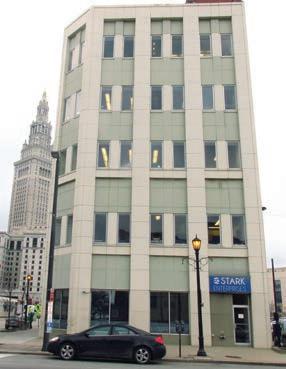
did not spell out how so. Stark had maintained the borrower did not make an $11,000 monthly payment due in January.
James Asimes, Realife’s director of acquisitions, responded to a ques tion about whether the dispute was link ed to a potential sale associated with Sherwin-Williams by writing in an email, “We continue to own and control the property, and expect that to be the case well into the future.” The bulk of the proposed Sher win-Williams downtown site incorporates two blocks of parking lots spanning the area from West Third to West S ixth Street, as well as Superior Avenue to West St. Clair and a parking lot on the w est side of Public Square that are owned by two other groups.
The tiny, 18,000-square-foot building sits on a piece of ground smaller than 1/10th of an acre, ac cording to county land records. Mark Jablonski, a real estate owner and developer who operates Centermark Development of University H eights, said in a phone interview that he can see why the paint and coatings giant might want to square off its ownership of the entire block. However, he added he does not feel it could derail such a momentous deal as it’s on the edge but not at the center of the proposed project.
If the parties do not settle, foreclo sure might pose less delay than previously, said Mike Sikora, managing p artner of Sikora Law LLC of Cleveland, since state law has strengthened the ability of receivers to sell pr operties. A Sherwin-Williams spokeswom an did not respond to emails about the b uilding on West Third.
Stan Bullard: sbullard@crain.com, (216) 771-5228, @CrainRltywriter crainscleveland.com Publisher/editor Elizabeth McIntyre (216) 771-5358 or emcintyre@crain.com Group publisher Mary Kramer (313) 446-0399 or mkramer@crain.com Managing editor Scott Suttell (216) 771-5227 or ssuttell@crain.com Sections editor Michael von Glahn (216) 771-5359 or mvonglahn@crain.com Creative director David Kordalski (216) 771-5169 or dkordalski@crain.com Web editor Damon Sims (216) 771-5279 or dasims@crain.com Associate editor/Akron Sue Walton (330) 802-4615 or swalton@crain.com Assistant editor Kevin Kleps (216) 771-5256 or kkleps@crain.com Senior data editor Chuck Soder (216) 771-5374 or csoder@crain.com Editorial researcher William Lucey (216) 771-5243 or wlucey@crain.com Cartoonist Rich Williams REPORTERS Stan Bullard, senior reporter, Real estate/ construction. (216) 771-5228 or sbullard@crain.com Jay Miller, Government. (216) 771-5362 or jmiller@crain.com Rachel Abbey McCafferty, Manufacturing/energy/ education. (216) 771-5379 or rmccafferty@crain.com Jeremy Nobile, Finance/legal/beer/cannabis. (216) 771-5255 or jnobile@crain.com Kim Palmer, Government. (216) 771-5384 or kpalmer@crain.com Dan Shingler, Energy/steel/auto/Akron. (216) 771-5290 or dshingler@crain.com Lydia Coutré, Health care/nonprofits. (216) 771-5479 or lcoutre@crain.com ADVERTISING Local sales manager Megan Norman, (216) 771-5182 or mnorman@crain.com Events manager Erin Bechler, (216) 771-5388 or ebechler@crain.com Integrated marketing manager Michelle Sustar, (216) 771-5371 or msustar@crain.com Managing editor custom/special projects Amy Ann Stoessel (216) 771-5155 or astoessel@crain.com Associate publisher Lisa Rudy Director of advertising sales Scott Carlson Senior account executive John Petty Account executives Laura Kulber Mintz, Loren Breen People on the Move manager Debora Stein, (917) 226-5470, dstein@crain.com Pre-press and digital production Craig L. Mackey Office coordinator Karen Friedman Media services manager Nicole Spell Billing YahNica Crawford Credit Thomas Hanovich CUSTOMER SERVICE Customer service and subscriptions: (877) 824-9373 or customerservice@crainscleveland.com Reprints: Laura Picariello (732) 723-0569 or lpicariello@crain.com
Crain’s Cleveland Business is published by Crain Communications Inc. Chairman Keith E. Crain Vice chairman Mary Kay Crain President KC Crain Senior executive VP Chris Crain Secretary Lexie Crain Armstrong Chief Financial Officer Robert Recchia G.D. Crain Jr., Founder (1885-1973) Mrs. G.D. Crain Jr., Chairman (1911-1996) Editorial & Business Offices 700 W. St. Clair Ave., Suite 310, Cleveland, OH 44113-1230 (216) 522-1383
Volume 41, Number 6 Crain’s Cleveland Business (ISSN 0197-2375) is published weekly, except for the first issue in January, July and September, the last issue in May and the fourth issue in November, at 700 West St. Clair Ave., Suite 310, Cleveland, OH 44113-1230. Copyright © 2020 by Crain Communications Inc. Periodicals postage paid at Cleveland, OH, and at additional mailing offices. Price per copy: $2.00. Postmaster: Send address changes to Crain’s Cleveland Business, Circulation Department, 1155 Gratiot Avenue, Detroit, MI 48207-2912. 1 (877) 824-9373. Subscriptions: In Ohio: 1 year - $64, 2 year - $110. Outside Ohio: 1 year - $110, 2 year - $195. Single copy, $2.00. Allow 4 weeks for change of address. For subscription information and delivery concerns send correspondence to Audience Development Department, Crain’s Cleveland Business, 1155 Gratiot Avenue, Detroit, MI, 48207-9911, or email to customerservice@crainscleveland.com, or call (877) 824-9373 (in the U.S. and Canada) or (313) 446-0450 (all other locations), or fax (313) 446-6777.
NOMINATIONS NOW OPEN

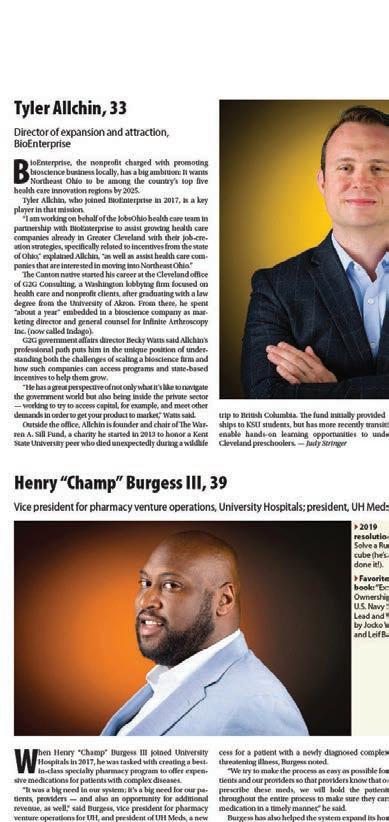


Crain’s honors eight individuals in their 80s or older who are still working tirelessly to advance Northeast Ohio and its residents. DEADLINE: March 6

Crain’s will single out 20 up-and-coming professionals who haven’t turned 30 yet but are already making a mark on Northeast Ohio. DEADLINE: March 20

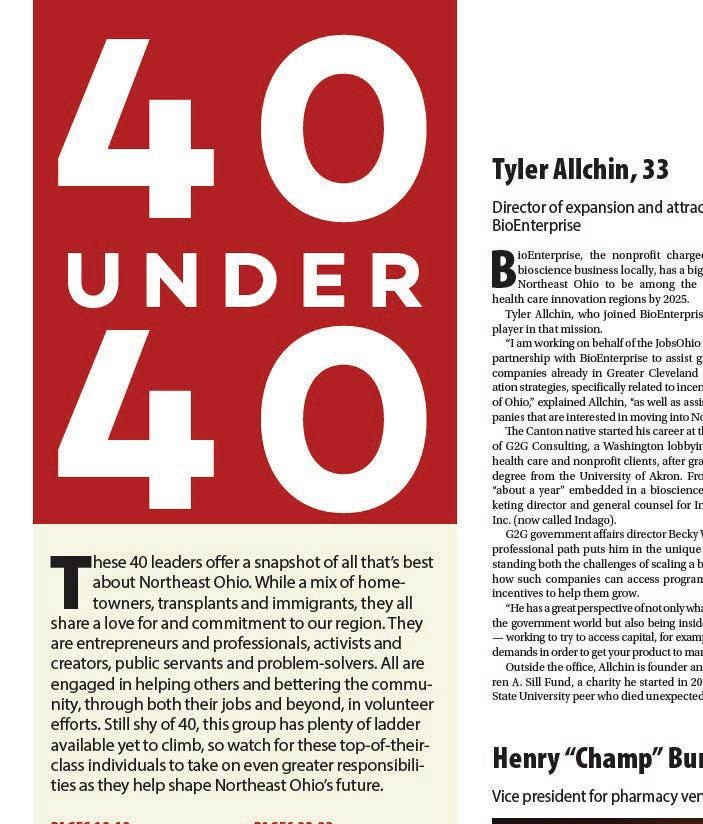

Crain’s honors the dedication and achievements of Northeast Ohio’s top female business leaders who enrich our region with their professional talents and unique perspectives. DEADLINE: April 10
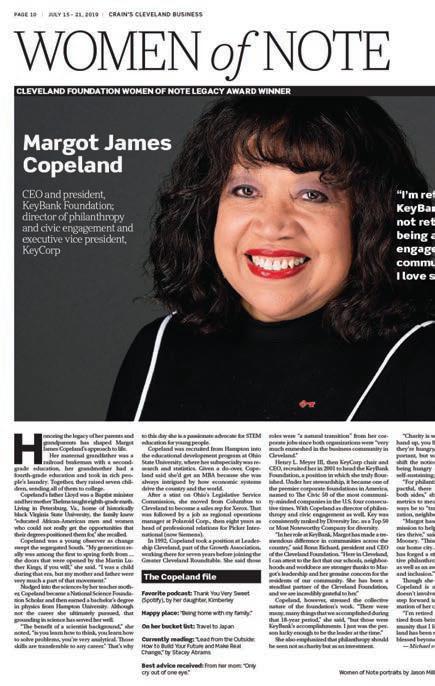
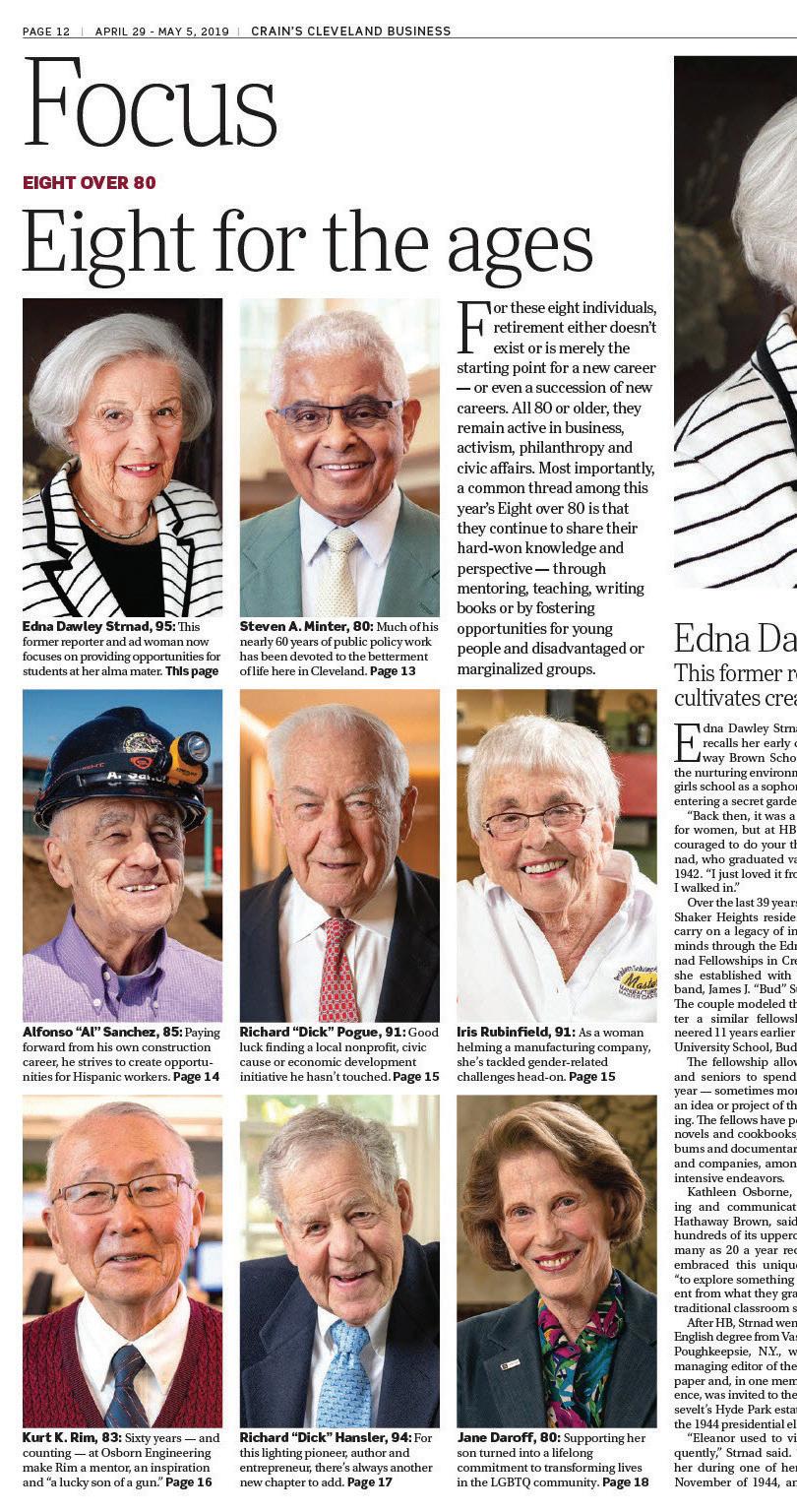
A tribute to the next generation of rising stars who have taken a leading role in our business community. DEADLINE: June 12



